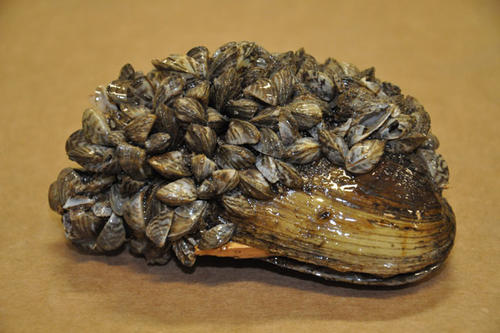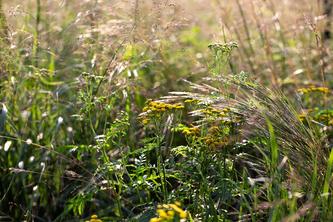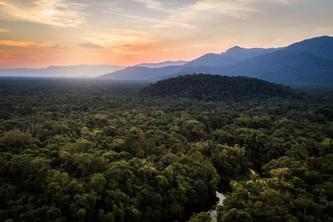
The Minnesota Aquatic Invasive Species Research Center (MAISRC) announced today a partnership with Tonka Bay Marina, the Brunswick Freshwater Boat Group and the Minnesota Department of Natural Resources to launch new research aimed at reducing the spread of invasive zebra mussels by recreational boaters.
This is the first phase of a program to identify the primary ways people spread zebra mussels. Specifically, this project will examine spread of aquatic invasive species (AIS) from “residual water”—water left in a boat after its operator has attempted to fully drain it.
To minimize the risk of spreading AIS, Minnesota law requires that drain plugs and other water-controlling devices be removed from boats and other water-related equipment when draining a boat. Further, these drain plugs must remain out and open while transporting boats and other water-related equipment.
Some watercraft for various reasons do not fully drain, instead retaining residual water in compartments and equipment such as engines, bilges, ballasts, and live wells to hold fish. This residual water can contain microscopic zebra mussel larvae called veligers, but a more comprehensive study of vessel types that are common on today’s lakes is needed to adequately evaluate the level of risk this water poses to the spread of zebra mussels.
Researchers will measure the amount and location of residual water in the compartments of different types of boats and equipment to evaluate concentrations and survival rates of zebra mussel veligers in residual water. These data would help boat designers and manufacturers identify where possible redesigns or retrofits might be warranted to reduce the inadvertent spread of these invaders. It would also influence the state’s AIS inspection procedures and decontamination requirements.
The role of residual water in zebra mussel spread was identified as a high priority in MAISRC’s 2014-2015 systematic assessment of research needs, and that assessment struck a chord with Tonka Bay Marina Chief Executive Officer Gabriel Jabbour.
“If boats owners are spending more time to clean these invasive species out of awkward nooks and crannies of their craft, it means less time on the lake,” Jabbour said. “And if a simple boat redesign could eliminate the problem, it just seems like a no-brainer.”
“We need the help of science now for the more complex boats,” Jabbour said. “Manufacturers may be in a position where a redesign now could head off more serious problems down the road. This research will show them what they may need to do.”
Dr. Michael McCartney, lead zebra mussel researcher at MAISRC, said he sees the benefit in boat manufacturers, boat inspectors, and boaters all being better informed about the role that residual water may play in the spread of AIS.
“To date, we've had limited data to understand the risk posed by veligers in residual water. This study will considerably improve the data set – and our confidence in evaluating that risk in order to minimize it,” he said.
“The results of this study will provide us with critical information that will be used to inform and, if need be, improve our inspection protocols,” Heidi Wolf, MN DNR Invasive Species Unit Supervisor added.
The DNR will contribute nearly $50,000 in-kind to the project. This includes statewide watercraft inspectors to collect samples, fleet travel, and boat use. MAISRC is contributing in-kind researcher salary, labs, and other facilities. Tonka Bay Marina is providing approximately $50,000 to support a graduate student and core research costs. Additionally, Tonka Bay Marina will be providing support through staff and facilities on Lake Minnetonka.
The Brunswick Freshwater Boat Group (FWG) designs and builds a wide variety of fishing boats and pontoons, and it is comprised of these leading brands: Crestliner, Cypress Cay, Harris, Lowe, Lund, and Princecraft. Crestliner and Lund are based in Minnesota.
In addition to a financial contribution, the Brunswick FWG will engage its Product Development & Engineering personnel in this project to better understand designs that would slow/eliminate the spread of aquatic invasive species.
“Such a collaborative effort among academia, business and regulators was quite appealing in tackling such a vexing concern as AIS,” said JD Sienicki, vice president – product development & engineering for the FWG. “We are looking forward to what may arise from this work, and how it will ultimately make boating more convenient and worry-free for boaters.”
###
About Minnesota Aquatic Invasive Species Research Center
MAISRC’s mission is to develop research-based solutions that can reduce the impacts of aquatic invasive species in Minnesota by preventing spread, controlling populations, and managing ecosystems; and to advance knowledge to inspire action by others. Funding for MAISRC is provided by the Environment and Natural Resources Trust Fund, the Clean Water Fund, and private donations. For more information, visit www.maisrc.umn.edu.
About Crestliner
Located in Otsego, Minn., Crestliner boats are crafted with an uncompromising mix of functional design, all-welded aluminum construction and fishing first innovations. Since 1946 Crestliner has been making boats forged with strength and defined by durability. As a worldwide leader, Crestliner continues to redefine the industry with boats built to last. A testament to our quality and craftsmanship, Crestliner has received the CSI Award of Excellence in Customer Satisfaction for Aluminum Outboard Boats for nine consecutive years. Learn more about Crestliner and its line of boats by visiting www.crestliner.com.
About Lund
Since 1948, Lund has been building boats from the heart of lakes country in New York Mills, Minnesota. Built with professional grade materials to withstand a lifetime of use, Lund Boats are guide tested and wilderness proven and demanded by more camps, resorts, fishing guides and professionals throughout North America. Whether the preference is aluminum or fiberglass, each boat is carefully designed with fishing features and optimal fishing layouts in mind. They're engineered for maximum performance and superior boat control to effortlessly stay on the breaks and catch more fish, delivering The Ultimate Fishing Experience. Lund Boats - Built by Fishermen for Fishermen.
Crestliner and Lund are divisions of Brunswick Corporation, a leader in the recreational marine industry. www.brunswick.com
About Brunswick
Headquartered in Lake Forest, Ill., Brunswick Corporation endeavors to instill "Genuine Ingenuity"(TM) in all its leading consumer brands, including Mercury and Mariner outboard engines; Mercury MerCruiser sterndrives and inboard engines; MotorGuide trolling motors; Attwood, Garelick and Whale marine parts and accessories; Land 'N' Sea, Kellogg Marine, Diversified Marine, BLA and Bell RPG parts and accessories distributors; Bayliner, Boston Whaler, Brunswick Commercial and Government Products, Crestliner, Cypress Cay, Harris, Lowe, Lund, Meridian, Princecraft, Quicksilver, Rayglass, Sea Ray and Uttern boats; Life Fitness, Hammer Strength, Cybex and SCIFIT fitness equipment; InMovement products and services for productive well-being; and Brunswick billiards tables, accessories and game room furniture. For more information, visit www.brunswick.com.
About Tonka Bay Marina
Tonka Bay Marina owns four locations on Lake Minnetonka as well as Skiff Craft handcrafted wooden boats in Ohio. For more information, visit www.tonkabaymarina.com
- Categories:
- Agriculture and Environment





